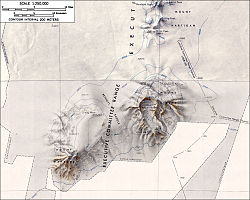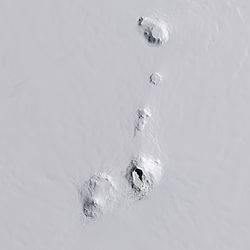Mount Sidley
| Mount Sidley | |
|---|---|
 Aerial view of the Mt. Sidley caldera from the southwest | |
| Highest point | |
| Elevation | 4,285 m (14,058 ft)[1][2] |
| Prominence | 2,517 m (8,258 ft)[1] |
| Listing | Volcanic Seven Summits, Ultra |
| Coordinates | 77°02′S 126°06′W / 77.033°S 126.100°WCoordinates: 77°02′S 126°06′W / 77.033°S 126.100°W[1] |
| Geography | |
 Mount Sidley Antarctica | |
| Location | Marie Byrd Land, Antarctica |
| Parent range | Executive Committee Range |
| Geology | |
| Mountain type | Stratovolcano |
| Volcanic field | Marie Byrd Land Volcanic Province |
| Climbing | |
| First ascent | 1990 by Bill Atkinson (New Zealand) |
Mount Sidley is the highest dormant volcano in Antarctica, a member of the Volcanic Seven Summits, with a summit elevation of 4,181–4,285 metres (13,717–14,058 ft).[1][2] It is a massive, mainly snow-covered stratovolcano which is the highest of the five volcanic mountains that comprise the Executive Committee Range of Marie Byrd Land. The feature is marked by a 5 km wide caldera[3] on the southern side and stands NE of Mount Waesche in the southern part of the range.
The mountain was discovered by Rear Admiral Richard E. Byrd on an airplane flight, November 18, 1934, and named by him for Mabelle E. Sidley, the daughter of William Horlick who was a contributor to the 1933–35 Byrd Antarctic Expedition.[4] Despite its height, the volcano's extremely remote location means that it is little known even in the mountaineering world compared to the much more accessible Mount Erebus, the second highest Antarctic volcano which is located near the U.S. and New Zealand bases on Ross Island.
The first recorded ascent of Mount Sidley was by New Zealander Bill Atkinson on January 11, 1990, whilst working in support of a United States Antarctic Program scientific field party.[5]


See also[]
Notes[]
- ^ a b c d "Antarctica Ultra-Prominent Summits". peaklist.org. Retrieved 2013-12-24.
- ^ a b . The map above showed the elevation as 4,181 m (13,717 ft).
- ^ Panter, Kurt S.; Kyle, Philip R.; Smellie, John L. (September 1997). "Petrogenesis of a Phonolite-Trachyte Succession at Mount Sidley, Marie Byrd Land, Antarctica". Journal of Petrology. 38 (9): 1225–1253. doi:10.1093/petroj/38.9.1225. ISSN 0022-3530.
- ^ "Mount Sidley". Geographic Names Information System. United States Geological Survey. Retrieved 2013-12-24.
- ^ Gildea, Damien (2015). Mountaineering in Antarctica: complete guide: Travel guide. Primento. ISBN 9782511031346.
References[]
- LeMasurier, W. E.; Thomson, J. W., eds. (1990). Volcanoes of the Antarctic Plate and Southern Oceans. American Geophysical Union. pp. 203–207. ISBN 0-87590-172-7.
- "Skiing the Pacific Ring of Fire and Beyond". Amar Andalkar's Ski Mountaineering and Climbing Site. 2007 [1997]. Retrieved 14 January 2005.
- Volcanic Seven Summits
- Polygenetic shield volcanoes
- Calderas of Antarctica
- Volcanoes of Antarctica
- Mountains of Marie Byrd Land
- Four-thousanders of Antarctica
- Executive Committee Range
- Pliocene volcanoes
